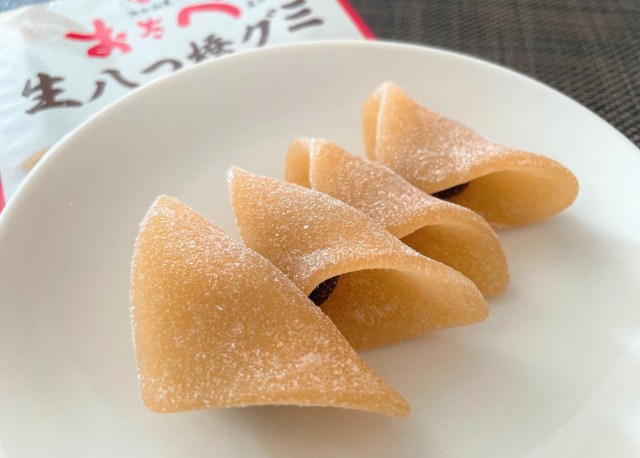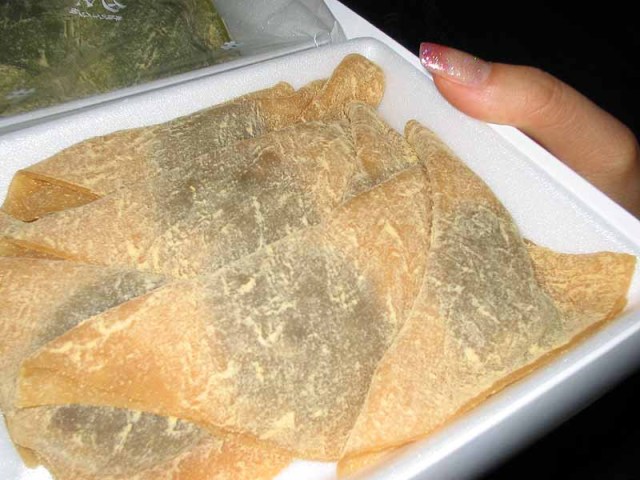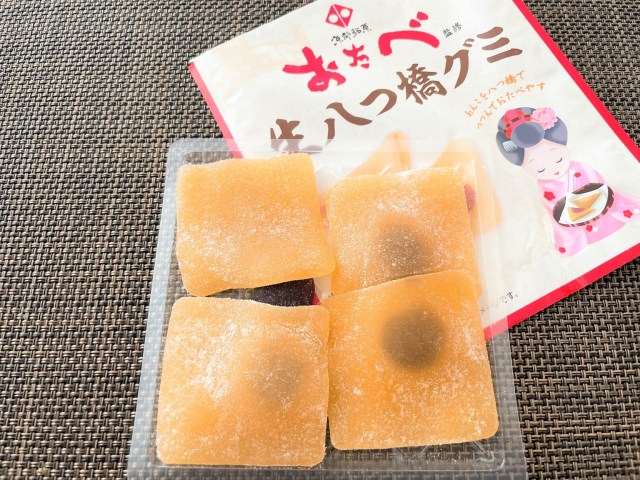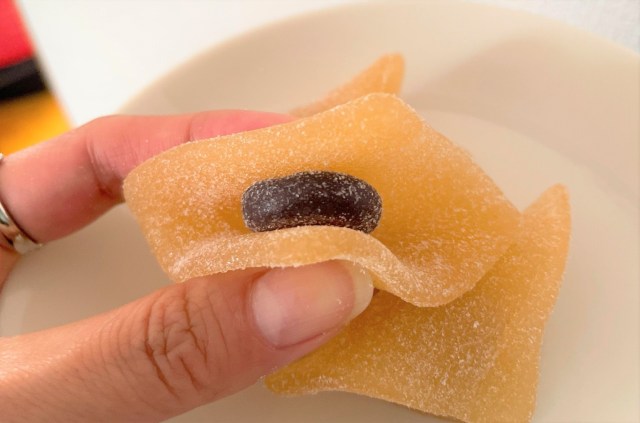
Want to get your yatsuhashi fix but live too far away from Kyoto? We’ve got the answer for you!
For fans of Japanese confectionary, there’s no place better to get your fix than the former capital city of Kyoto. Whether you’re looking for Japan’s oldest sweet or something modern yet elegant, you need look no further than Kyoto.
One of Kyoto’s most famous sweets are yatsuhashi, a triangular Japanese sweet made from glutinous rice flour, sugar and often cinnamon. There are three kinds of yatsuhashi, but arguably the most popular variety is the unbaked version with a red bean filling, called ‘nama yatsuhashi’.
▼ Nama yatsuhashi is a popular souvenir to bring back from Kyoto and comes in boxes like this.
Our Kansai-based Japanese language reporter K. Masami is lucky enough to be able to enjoy a delicious yatsuhashi whenever she wants, but for those of us who live far away from Kyoto, we have to rely on travelling friends and co-workers to bring us back some sweet treats.
However, upon a recent visit to her local drugstore, Masami came across something that changes everything — yatsuhashi gummy candies.
▼ The yatsuhashi gummies are made by famous Kyoto-based confectionary company Otabe
The gummy candies cost 214 yen (US$1.89) for a packet of four, compared to the price of Otabe’s regular nama yatsuhashi, costing 594 yen (US$5.23) for a pack of ten.
At a glance, you could definitely mistake these for actual nama yatsuhashi; the red bean filling was visible from the outside, and the texture and colour looked very similar to that of real nama yatsuhashi.
As Masami picked up one of the yatsuhashi, she noticed the ‘red bean paste’ wasn’t actually inside the sweet like expected, but underneath, meaning she’d have to add the filling and fold the outside herself. Masami is already well versed in the art of making traditional Japanese sweets, so assembling this yatsuhashi was but a walk in the park. Still, she’d always wanted to be able to add “can make yatsuhashi sweets” to her resume, and this was a novel way of doing it.
▼ Turns out it’s not actually that hard to do.
As Masami folded the outer layer of the yatsuhashi, she was immediately reminded that she was dealing with gummy candy and not real yatsuhashi, as the outer layer sprang back to its original square shape. The sugary coating kept making Masami’s fingers fairly sticky, but despite all of that she was having fun making her own traditional Kyoto sweets, albeit in a gummy form.
But presentation wasn’t Masami’s biggest concern; it was time for the taste test. How did it compare to real nama yatsuhashi?
Well, it certainly tasted similar, but there was a huge difference in the texture, and the chewy candy wasn’t as soft as real yatsuhashi. The flavour of cinnamon and red bean paste really shone through though, and if her tongue were to suddenly stop working, they would probably be indistinguishable from real nama yatsuhashi.
An added bonus to the gummy candy yatsuhashi is its long shelf life; the candies Masami bought weren’t set to expire for another six months, giving her plenty of time to get her Kyoto candy fill.
▼ Or you can just eat them all in one go, Masami. We promise we won’t judge.
Otabe’s Nama Yatsuhashi Gummies can be found throughout Japan in drugstores and supermarkets, so if you’re looking for a fun way to enjoy some traditional Japanese sweets, or are just craving yatsuhashi but live too far away, Masami recommends giving this gummy version a try.
Whether you share them with your co-workers, hold a yatsuhashi party and make them with friends, or just keep them all to yourself, you’re sure to have a good time with these. Of course for some, nothing quite beats the real thing, especially when they look as cute as these maiko yatsuhashi from Kyoto.
Photos ©SoraNews24 unless otherwise mentioned
● Want to hear about SoraNews24’s latest articles as soon as they’re published? Follow us on Facebook and Twitter!
[ Read in Japanese ]

 Image:
Image: 



 Pikachu and Kyoto candy maker team up for confectionary collaboration centuries in the making
Pikachu and Kyoto candy maker team up for confectionary collaboration centuries in the making Crepe made with Kyoto sweets and green tea is the perfect treat after a day of temple hopping
Crepe made with Kyoto sweets and green tea is the perfect treat after a day of temple hopping Sweet omelette-flavored gummies? Famous Japanese YouTuber tries it so you don’t have to!
Sweet omelette-flavored gummies? Famous Japanese YouTuber tries it so you don’t have to! ‘Butter mochi’ flavoured chocolate may be the best kind of Tirol we’ve ever tasted
‘Butter mochi’ flavoured chocolate may be the best kind of Tirol we’ve ever tasted Kyoto curry bread comes with a very special filling
Kyoto curry bread comes with a very special filling Foreigner’s request for help in Tokyo makes us sad for the state of society
Foreigner’s request for help in Tokyo makes us sad for the state of society Japanese city loses residents’ personal data, which was on paper being transported on a windy day
Japanese city loses residents’ personal data, which was on paper being transported on a windy day Should you add tartar sauce to Japanese curry rice? CoCo Ichi makes diners an unusual offer
Should you add tartar sauce to Japanese curry rice? CoCo Ichi makes diners an unusual offer Ghibli Park now selling “Grilled Frogs” from food cart in Valley of Witches
Ghibli Park now selling “Grilled Frogs” from food cart in Valley of Witches Red light district sushi restaurant in Tokyo shows us just how wrong we were about it
Red light district sushi restaurant in Tokyo shows us just how wrong we were about it Historical figures get manga makeovers from artists of Spy x Family, My Hero Academia and more
Historical figures get manga makeovers from artists of Spy x Family, My Hero Academia and more Suntory x Super Mario collaboration creates a clever way to transform into Mario【Videos】
Suntory x Super Mario collaboration creates a clever way to transform into Mario【Videos】 Akihabara pop-up shop sells goods made by Japanese prison inmates
Akihabara pop-up shop sells goods made by Japanese prison inmates Japanese ramen restaurants under pressure from new yen banknotes
Japanese ramen restaurants under pressure from new yen banknotes Beautiful Red and Blue Star luxury trains set to be Japan’s new Hokkaido travel stars
Beautiful Red and Blue Star luxury trains set to be Japan’s new Hokkaido travel stars McDonald’s new Happy Meals offer up cute and practical Sanrio lifestyle goods
McDonald’s new Happy Meals offer up cute and practical Sanrio lifestyle goods French Fries Bread in Tokyo’s Shibuya becomes a hit on social media
French Fries Bread in Tokyo’s Shibuya becomes a hit on social media Studio Ghibli releases new action figures featuring Nausicaä of the Valley of the Wind characters
Studio Ghibli releases new action figures featuring Nausicaä of the Valley of the Wind characters New private rooms on Tokaido Shinkansen change the way we travel from Tokyo to Kyoto
New private rooms on Tokaido Shinkansen change the way we travel from Tokyo to Kyoto Tokyo Tsukiji fish market site to be redeveloped with 50,000-seat stadium, hotel, shopping center
Tokyo Tsukiji fish market site to be redeveloped with 50,000-seat stadium, hotel, shopping center All-you-can-drink Starbucks and amazing views part of Tokyo’s new 170 meter-high sky lounge
All-you-can-drink Starbucks and amazing views part of Tokyo’s new 170 meter-high sky lounge Beautiful Ghibli sealing wax kits let you create accessories and elegant letter decorations【Pics】
Beautiful Ghibli sealing wax kits let you create accessories and elegant letter decorations【Pics】 Studio Ghibli releases Kiki’s Delivery Service chocolate cake pouches in Japan
Studio Ghibli releases Kiki’s Delivery Service chocolate cake pouches in Japan New definition of “Japanese whiskey” goes into effect to prevent fakes from fooling overseas buyers
New definition of “Japanese whiskey” goes into effect to prevent fakes from fooling overseas buyers Our Japanese reporter visits Costco in the U.S., finds super American and very Japanese things
Our Japanese reporter visits Costco in the U.S., finds super American and very Japanese things Studio Ghibli unveils Mother’s Day gift set that captures the love in My Neighbour Totoro
Studio Ghibli unveils Mother’s Day gift set that captures the love in My Neighbour Totoro More foreign tourists than ever before in history visited Japan last month
More foreign tourists than ever before in history visited Japan last month New Pokémon cakes let you eat your way through Pikachu and all the Eevee evolutions
New Pokémon cakes let you eat your way through Pikachu and all the Eevee evolutions Sales of Japan’s most convenient train ticket/shopping payment cards suspended indefinitely
Sales of Japan’s most convenient train ticket/shopping payment cards suspended indefinitely Sold-out Studio Ghibli desktop humidifiers are back so Totoro can help you through the dry season
Sold-out Studio Ghibli desktop humidifiers are back so Totoro can help you through the dry season Japanese government to make first change to romanization spelling rules since the 1950s
Japanese government to make first change to romanization spelling rules since the 1950s Ghibli founders Toshio Suzuki and Hayao Miyazaki contribute to Japanese whisky Totoro label design
Ghibli founders Toshio Suzuki and Hayao Miyazaki contribute to Japanese whisky Totoro label design Doraemon found buried at sea as scene from 1993 anime becomes real life【Photos】
Doraemon found buried at sea as scene from 1993 anime becomes real life【Photos】 Tokyo’s most famous Starbucks is closed
Tokyo’s most famous Starbucks is closed One Piece characters’ nationalities revealed, but fans have mixed opinions
One Piece characters’ nationalities revealed, but fans have mixed opinions We asked a Uniqlo employee what four things we should buy and their suggestions didn’t disappoint
We asked a Uniqlo employee what four things we should buy and their suggestions didn’t disappoint Princesses, fruits, and blacksmiths: Study reveals the 30 most unusual family names in Japan
Princesses, fruits, and blacksmiths: Study reveals the 30 most unusual family names in Japan Japan’s sweet/terrifying face cakes are here as we order a batch of Kao Dorayaki【Photos】
Japan’s sweet/terrifying face cakes are here as we order a batch of Kao Dorayaki【Photos】 Weird Japanese vending machine find gives us unique sweet potato sweets
Weird Japanese vending machine find gives us unique sweet potato sweets Hard Rock Cafe opening in Kyoto in beautiful machiya townhouse building【Photos】
Hard Rock Cafe opening in Kyoto in beautiful machiya townhouse building【Photos】 We try some “raw” dorayaki from Kyoto and are overwhelmed with its thickness
We try some “raw” dorayaki from Kyoto and are overwhelmed with its thickness We try a delicious hidden gem in Fukuoka, unknown to even Japanese people
We try a delicious hidden gem in Fukuoka, unknown to even Japanese people How many do you know? 12 delicious foods in Japanese supermarkets and convenience stores
How many do you know? 12 delicious foods in Japanese supermarkets and convenience stores Japan’s hardest rice crackers, snacks of the shinobi, go soft, so do they have a reason to exist?
Japan’s hardest rice crackers, snacks of the shinobi, go soft, so do they have a reason to exist? Starbucks Japan reveals new Sakura Frappuccino for 2022
Starbucks Japan reveals new Sakura Frappuccino for 2022 Colorful custom Cup Noodles sold at Momofuku Noodle in Osaka with 2,145 different varieties
Colorful custom Cup Noodles sold at Momofuku Noodle in Osaka with 2,145 different varieties Asahi Super Dry’s draft beer in a can, the Nama Jockey Can, is here【Taste test】
Asahi Super Dry’s draft beer in a can, the Nama Jockey Can, is here【Taste test】 Win Pikachu-shaped gummy goods in Kanro’s Pikachu sweets campaign!
Win Pikachu-shaped gummy goods in Kanro’s Pikachu sweets campaign! Pikachu-shaped electric shock-flavor gummies are coming to Japan!
Pikachu-shaped electric shock-flavor gummies are coming to Japan! We test out 100-yen shop Halloween pet accessories on a purrfectly cute assistant
We test out 100-yen shop Halloween pet accessories on a purrfectly cute assistant How women can shoot down dessert dates before they’re even invited, according to Japanese Twitter
How women can shoot down dessert dates before they’re even invited, according to Japanese Twitter Kyoto “Cloud Drink” lets you taste the weather as it turns into rain and disappears into your tea
Kyoto “Cloud Drink” lets you taste the weather as it turns into rain and disappears into your tea
Leave a Reply